
Table of contents:
- Author Bailey Albertson [email protected].
- Public 2024-01-17 22:26.
- Last modified 2025-06-01 07:32.
Picky ceiling: the nuances of painting the ceiling in the kitchen
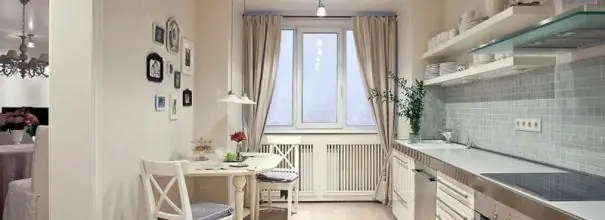
If the kitchen ceiling had character, it would be considered capricious. The fact is that the condition of the surface above the head strongly depends on the operating conditions of the room, and in the kitchen they are quite tough. Therefore, the requirements for painting the ceiling at the place of cooking should be increased.
Content
- 1 What to take note of when preparing to paint the kitchen ceiling
-
2 Choice of paint
- 2.1 Acrylic
- 2.2 Water based
- 2.3 Alkyd
- 2.4 Silicone
- 2.5 Lime
- 3 Color selection
-
4 Painting the ceiling with your own hands
- 4.1 Materials and tools required
- 4.2 Ceiling preparation
-
4.3 Stages of work
4.3.1 Video: how to paint a ceiling without staining
-
5 Kitchen design when painting the ceiling
5.1 Photo gallery: an interesting design of a kitchen with a painted ceiling
What to take note of when preparing to paint the kitchen ceiling
When planning to paint the ceiling in the kitchen, you should be aware of the fact that this room is characterized by:
- high humidity arising as a result of constant filling with vapors from cooking;
- temperature jumps caused either by the heating of the room with hot food vapor (up to 60 ° C), then by its cooling due to the opening of the window (up to 0 ° C);
- grease and soot that appears on all surfaces as a result of cooking in an open pan;
- there is a great risk of flooding, because water pipes pass through the kitchen.
Paint selection
Several types of products are suitable for coloring the kitchen ceiling.
Acrylic
Acrylic paint is a water-dispersed solution with a high content of polyacrylates. The acrylic composition for the ceiling has the following advantages:
- even distribution over the surface;
- instant and hassle-free application;
- momentary drying;
- harmlessness (due to the composition without toxic substances);
- rich palette of colors;
- the possibility of merging different shades;
- abrasion resistance;
- high temperature tolerance.
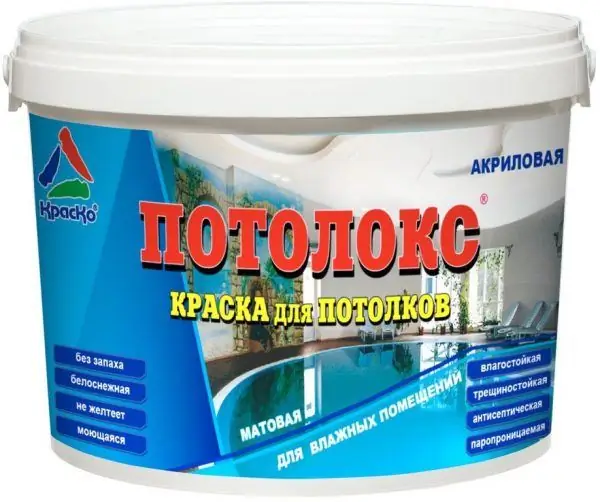
A layer of acrylic paint becomes durable only 7 days after application
The disadvantages of acrylic paint applied to the kitchen ceiling include:
- the need to very carefully clean from dirt (perhaps only wiping with a slightly damp cloth);
- high price;
- the acquisition of final strength only after 1-2 weeks.
Water emulsion
Water-based paint is an emulsion consisting of water, polymer particles and pigments. This tool has such advantages as:
- faint smell;
- composition without harmful components;
- instant adhesion to the surface even in a cold room;
- versatile use (for painting concrete, wood and brick, but not metal);
- removal with water if necessary;
- the ability to combine different tones in order to obtain the desired shade.
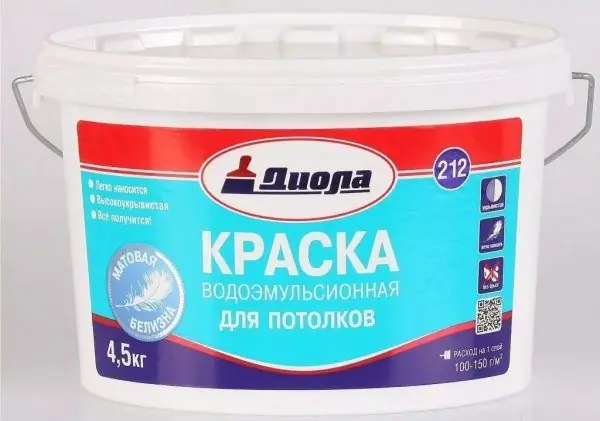
Water-based paint is afraid of moisture, therefore, water must not get on the ceiling painted with it
The disadvantages of water-based paint are:
- a taboo on cleaning the surface painted by it with water, soap solution or detergent;
- relatively short service life, which is associated with a strong susceptibility to moisture (no more than 4 years).
Alkyd
Alkyd paint is a composition with a high content of alkyd varnish and a solvent, the role of which can be played by white spirit or refined kerosene. The advantages of paint on the kitchen ceiling are:
- abrasion resistance, thanks to which the painted surface is not afraid of frequent washing;
- independence from changes in air temperature and dampness;
- easy and quick application;
- contact with any surfaces;
- the presence of both sparkling and non-shiny shades;
- washing with detergents (albeit without aggressive chemicals);
- wide palette of tones.

Alkyd paint smells strong and is difficult to remove
The shortcomings of the alkyd dye composition include:
- acrid odor;
- significant cost;
- removal only with a solvent.
Silicone
Silicone based paint is an emulsion in which water, resins and organic particles are mixed. Among the advantages of this means for the ceiling are the following:
- adaptability to difficult operating conditions in the kitchen;
- maintaining integrity, despite temperature fluctuations;
- insensitivity to moisture, which is expressed in the absence of fungus and mold;
- unpretentious care (grease and soot are removed with cleaning agents);
- long service life;
- elasticity of the composition, which allows masking surface defects;
- independence from temperature drops and excessive humidity.

Silicone paint has enviable elasticity, so it perfectly hides the defects of the ceiling
The disadvantages of silicone paint are:
- the need to carefully clean with a semi-dry, and not abundant damp cloth;
- high price.
Lime
Lime is a material obtained by roasting and subsequent slaking of limestone and chalk. The consistency of using lime for painting the ceiling is proved by the advantages of the product:
- harmless composition;
- the ability to absorb toxins from the outside;
- low cost;
- masking minor surface flaws.
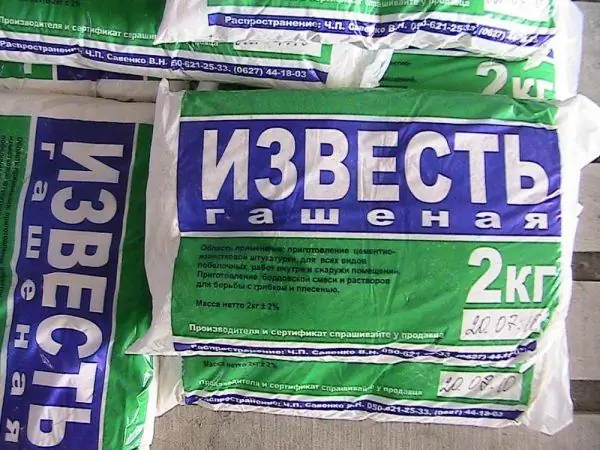
Slaked lime is considered the easiest way to decorate the ceiling.
But whitewashing also has disadvantages:
- the formation of irregularities (after applying several layers of the composition);
- boring white tone, which is not able to make the ceiling beautiful from the designer's point of view;
- ban on water purification;
- the need to reapply the composition if you need to get rid of grease and soot.
Color selection
To determine the color, you need to know that:
- visual expansion of space is achieved by using light sparkling shades;
-
the optimal shade of the ceiling is the one that is lighter than the walls by 3 or 4 tones;

Kitchen with a ceiling slightly lighter than the walls The ceiling should be lighter than the walls, otherwise there will be a visual distortion of the size of the kitchen
- dark matte colors visually reduce the distance between the ceiling and the floor;
-
in the kitchen, using different shades, you can divide the space into a work and dining area;

Kitchen with a ceiling that divides the kitchen into zones The ceiling can be painted in two colors, thereby separating the work area from the dining room
- the color of the ceiling should not create dissonance with the shades of other kitchen surfaces.
DIY ceiling painting
Finishing the ceiling with paint begins with preparatory work.
Required materials and tools
For painting are used:
- ladder;
- spatulas of different widths;
- sponge;
- a piece of cloth (or a brush with soft bristles);
- long-handled roller (or spray gun);
- brush;
- container for coloring emulsion;
-
masking tape;

Ceiling painting tools To paint the ceiling you need not only a brush and a roller, but also masking tape.
- putty;
- mesh for grinding putty;
- primer;
- container for a primer;
- work clothes;
- protective glasses.
Ceiling preparation
The ceiling will be ready for staining after such manipulations as:
-
Moisten the old coating with water or soapy water, and if it is moisture resistant - with a special wash.

The process of cleaning the ceiling from the old coating Remove old coating with soapy water and a sponge
-
Scraping off the softened layer with a spatula.

The process of removing a wet coating with a spatula After moistening, the old paint can be easily removed with a spatula, after putting on respiratory protection
-
Treatment of minor flaws and cracks in the base with a primer, and then blocking with a putty.

Ceiling leveling process Using a putty knife and putty, the ceiling gets rid of pits
- Elimination of serious defects more than 1 cm deep with plaster mortar.
- Application of a finishing thin layer of putty over the entire area of the ceiling.
- Grinding the surface 6 hours after applying the putty, first with a coarse mesh and then with a fine mesh until the base is perfectly flat.
- Checking the evenness of the ceiling with a straight rail.
-
Priming the surface in 2 layers with a break necessary for drying the product.

Ceiling primer process In order to improve the adhesion of the ceiling material with the paint, a primer is used
Stages of work
Ceiling painting is carried out in 5 stages:
-
All areas of the room in contact with the ceiling and at risk of getting dirty with paint are sealed with masking tape.

The process of gluing baseboards with masking tape Ceiling skirting boards are primarily protected from paint with masking tape.
-
Hard-to-reach places and the area around the perimeter of the ceiling are painted with a brush.

The process of applying paint around the perimeter of the ceiling Hard-to-reach places are painted not with a roller, but with a brush
-
The remaining area is covered with paint using a roller or spray gun. The initial layer of the emulsion is applied perpendicular to the window opening. At the same time, pauses are avoided, otherwise stripes will appear on the ceiling as a result of the merger of already dried paint with a new portion of the composition.

Ceiling painting process The roller is rolled on the ceiling without taking breaks
- The final layer of the emulsion is smeared on the ceiling, waiting for the first to dry. This time, the work is done moving parallel to the window.
Video: how to paint the ceiling without staining
Kitchen design when painting the ceiling
Whatever the interior of the kitchen, in many cases white acrylic paint or another composition, but always light, is chosen for the ceiling. This allows you to create harmony, even if the kitchen has a black set and dark household appliances.
Ceiling painting usually forces kitchen owners to use traditional materials and maintain a strict design style.
Photo gallery: interesting design of a kitchen with a painted ceiling
-

Kitchen with white ceiling - White painted ceiling looks great with a glossy headset
-

Kitchen with a white ceiling and a light brown set - In the kitchen with a white painted ceiling, you can use blue and brown tones, as well as MDF headsets
-

Kitchen with painted ceiling and dark furniture - If the ceiling is covered with matte paint, then the upper part of the headset and a dark plastic apron can shine in the kitchen
-

Kitchen with painted ceiling and tiles on the floor - The floor of a kitchen with a painted ceiling is often tiled.
-

Kitchen with painted ceiling, laminate and tiles - The ceiling of the room, where there is a laminate on the floor and furniture made of metal and marble, should be painted with high-quality paint
-

Kitchen ceiling with wallpaper - Simple paint on the ceiling is successfully combined with interesting wallpaper on the walls
-

Kitchen with white glossy ceiling - A kitchen with a glossy white ceiling will sparkle with cleanliness when furnished with light-colored furniture
-

Brushed kitchen ceiling - In the kitchen, where there are shiny interior items, the ceiling can be made matte
The ceiling of the kitchen requires a special attitude towards itself. He doesn't like all types of paints. In addition to this, the kitchen ceiling needs special preparation before painting and does not tolerate technology violations.
Recommended:
Do-it-yourself Painting The Ceiling With Water-based Paint: Step-by-step Instructions With Photos And Videos
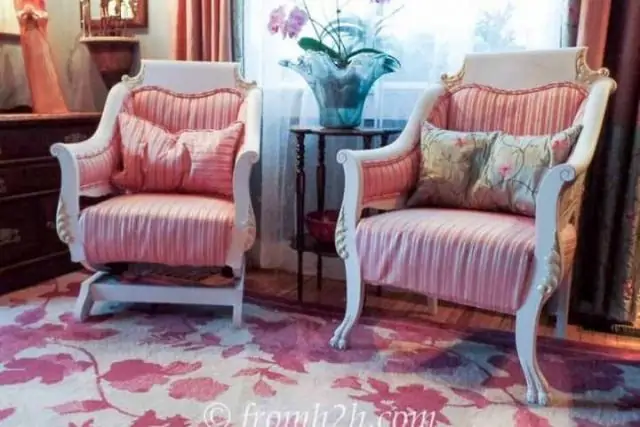
Features of self-painting the ceiling with water-based paint, tools, preparation of the ceiling. Step-by-step description of the process, error correction
Do-it-yourself Painting Of Doors: Features For Different Types Of Canvas, The Choice Of Paint And Varnish, Stages Of Work
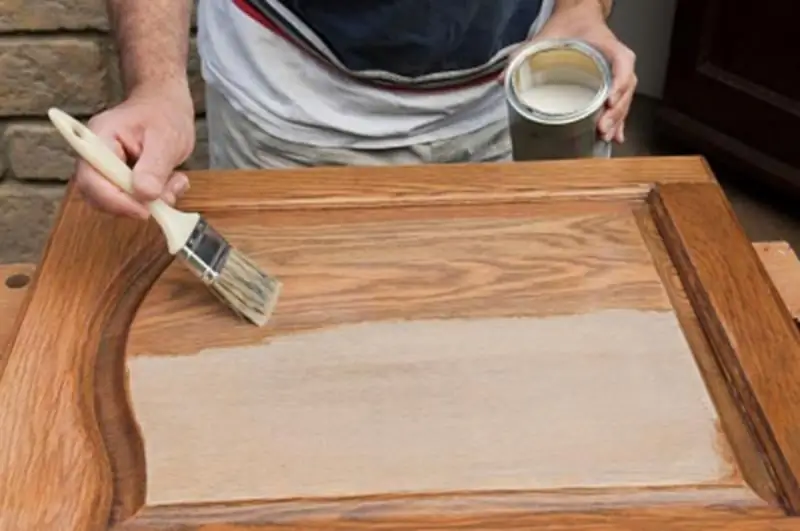
Door leaf coating technology. Preparatory work before painting. Selection of materials and tools. Sequence of work. Photo and video
Painting Wooden Doors: Which Paint Is Better To Choose, As Well As How To Properly Varnish The Surface

How to prepare a door for painting and which product to choose. Tools and materials for painting wooden doors. How to paint yourself
How To Choose A Laminate For The Kitchen: Types, Pros And Cons, Recommendations, Reviews, Photos Before And After Installation

Advantages and disadvantages of laminate flooring in the kitchen, as well as the rules for choosing and maintaining flooring. Features of kitchen design with laminate
A Simple Way To Redecorate The Ceiling: How To Properly Glue The Ceiling Tiles, Step-by-step Recommendations + Photos And Videos
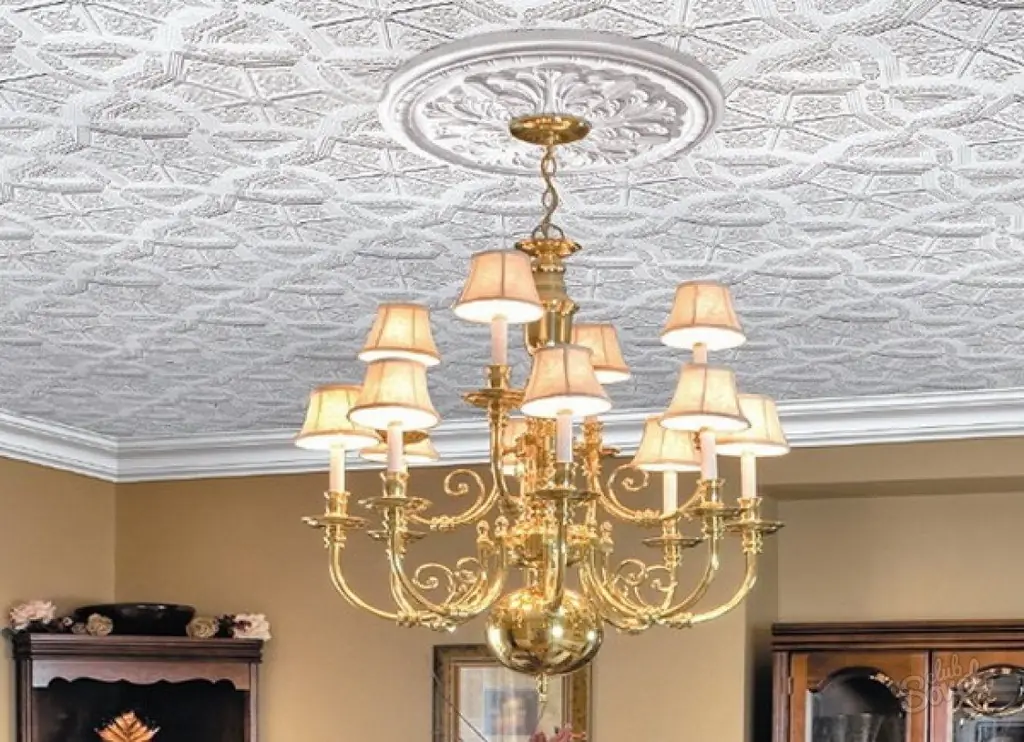
Practical advice on ceiling renovation with ceiling tiles. How to choose the right tile, glue. Tile installation methods
